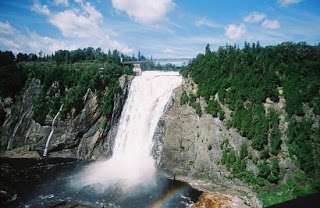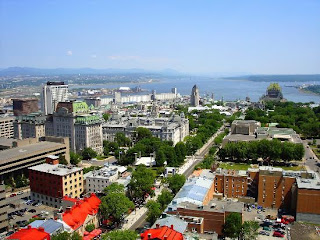 The Historic District of Québec is one of the oldest settlements in Canada, and the first to have been founded with the explicit goal of receiving permanent settlement and not as a commercial outpost. It was founded by Samuel de Champlain on 3 July 1608 at the site of a long abandoned St. Lawrence Iroquoian settlement called Stadacona. The Historic District of Québec was designated a WHS because it is the most complete fortified colonial town left in North America, and because as the capital of New France it marks a stage in the modern development of this continent. There a very few historic towns on the North American continent, at least by European standards, but Québec is one of them and could easily hold its own in the Old World. The citadel, the cathedral, all the old buildings like the Chateau Frontenac, cannons everywhere - e.g. on the battlefield of the Plains of Abraham -, even a real city wall (I believe the only one on this side of the Atlantic) give Québec a real medieval feel. Add the fact that this city is about 99% French-speaking and you won´t believe where you are. This city is highly recommended, but only during the warmer months - in winter it must be terribly cold there, even though there is a winter carnival. Could be interesting as well. Besides being the only walled city in North America north of Mexico, Quebec City is an authentic slice of the Old World situated in the heart of the
The Historic District of Québec is one of the oldest settlements in Canada, and the first to have been founded with the explicit goal of receiving permanent settlement and not as a commercial outpost. It was founded by Samuel de Champlain on 3 July 1608 at the site of a long abandoned St. Lawrence Iroquoian settlement called Stadacona. The Historic District of Québec was designated a WHS because it is the most complete fortified colonial town left in North America, and because as the capital of New France it marks a stage in the modern development of this continent. There a very few historic towns on the North American continent, at least by European standards, but Québec is one of them and could easily hold its own in the Old World. The citadel, the cathedral, all the old buildings like the Chateau Frontenac, cannons everywhere - e.g. on the battlefield of the Plains of Abraham -, even a real city wall (I believe the only one on this side of the Atlantic) give Québec a real medieval feel. Add the fact that this city is about 99% French-speaking and you won´t believe where you are. This city is highly recommended, but only during the warmer months - in winter it must be terribly cold there, even though there is a winter carnival. Could be interesting as well. Besides being the only walled city in North America north of Mexico, Quebec City is an authentic slice of the Old World situated in the heart of the  New.A mere 9-10 hour drive from New York City, Quebec offers a genuine European experience without having to cross the pond. Dominating the pleasant Haute Terre (upper town) area, is the monolithic Chateau Frontenac, a fancy hotel that serves as the city's icon. Nearby is a scenic promenade overlooking the mighty St. Lawrence and the pedestrian are of Basse Terre (lower town) with its scores of restaurants and souvenir shops. All in all its a great place to sate the inner francophile in all of us.
New.A mere 9-10 hour drive from New York City, Quebec offers a genuine European experience without having to cross the pond. Dominating the pleasant Haute Terre (upper town) area, is the monolithic Chateau Frontenac, a fancy hotel that serves as the city's icon. Nearby is a scenic promenade overlooking the mighty St. Lawrence and the pedestrian are of Basse Terre (lower town) with its scores of restaurants and souvenir shops. All in all its a great place to sate the inner francophile in all of us.Architecture
Château Frontenac, in the Haute-Ville (Upper Town)
 Much of the city's best architecture is located east of the fortification walls in Vieux-Québec (Old Quebec) and Place Royale. This area has a distinct European feel with its stone buildings and winding streets lined with shops and restaurants. Porte St-Louis and Porte St-Jean are the main gates through the walls from the modern section of downtown. West of the walls are the Parliament Hill district and the Plains of Abraham.
Much of the city's best architecture is located east of the fortification walls in Vieux-Québec (Old Quebec) and Place Royale. This area has a distinct European feel with its stone buildings and winding streets lined with shops and restaurants. Porte St-Louis and Porte St-Jean are the main gates through the walls from the modern section of downtown. West of the walls are the Parliament Hill district and the Plains of Abraham.The Upper Town is linked by the Escalier «casse-cou» (literally "neck-breaking" steps) and the Old Quebec Funicular to the Lower Town, which includes such sites as the ancient Notre Dame des Victoires church, the historic Petit Champlain district, the port, and the Musée de la Civilisation (Museum of Civilization). The Lower Town is filled with original architecture and street designs, dating back to the city's beginnings. Murals and statues are also featured. The Lower Town is also noted for its wide variety of boutiques, many featuring hand-crafted goods.Quebec City's skyline is dominated by the massive Château Frontenac Hotel, perched on top of Cap-Diamant. The hotel is beside the Terrasse Dufferin (Dufferin Terrace), a walkway along the edge of the cliff, offering beautiful views of the Saint Lawrence River.
The Terrasse Dufferin leads toward the nearby Plains of Abraham, site of the battle in which the British took Quebec from France, and the Citadelle of Quebec, a Canadian Forces installation and the federal vice-regal secondary residence. The Parliament Building, the meeting place of the Parliament of Quebec, is also near the Citadelle.
Near the Château Frontenac is Notre-Dame de Québec Cathedral, mother church of the Roman Catholic Archdiocese of Quebec. It is the first church in the New World to be raised to a basilica and is the primatial church of Canada.
Tourism
 Quebec City is known for its Winter Carnival and for its Saint-Jean-Baptiste Day celebrations.
Quebec City is known for its Winter Carnival and for its Saint-Jean-Baptiste Day celebrations.
Tourist attractions located near Quebec City include Montmorency Falls and the Basilica of Sainte-Anne-de-Beaupré. Jardin zoologique du Québec, reopened in 2002 after two years of restorations but closed in 2006 after a political decision. It featured 750 specimens of 300 different species of animals. The zoo specialized in winged fauna and garden themes, but also presented several species of mammals. While it emphasizes the indigenous fauna of Quebec, one of its principal attractions was the Indo-Australian greenhouse, featuring fauna and flora from these areas. Parc Aquarium du Québec, reopened in 2002 on a site overlooking the St. Lawrence River, presents more than 10,000 specimens of mammals, reptiles, fish and other aquatic fauna of North America and the Arctic. Polar bears and various species of seals of the Arctic sector and the "Large Ocean", a large basin offering visitors a view from underneath, form part of the principal attractions.
Parc Aquarium du Québec, reopened in 2002 on a site overlooking the St. Lawrence River, presents more than 10,000 specimens of mammals, reptiles, fish and other aquatic fauna of North America and the Arctic. Polar bears and various species of seals of the Arctic sector and the "Large Ocean", a large basin offering visitors a view from underneath, form part of the principal attractions.
Transport
Air and sea
Quebec City is served by Jean Lesage International Airport, located in the West of the city.
The city also has a large major port on the St-Lawrence in the first, fifth and sixth boroughs.
Roads Three bridges, the Quebec Bridge and Pierre Laporte Bridge connect the city with the south shore of the Saint Lawrence River, as does a ferry service to Lévis, and Orleans Island Bridge connects Quebec City with the Orleans Island. The city is a major hub in the Quebec provincial road network, fanning out from both sides of the river with an extensive autoroute system.
Three bridges, the Quebec Bridge and Pierre Laporte Bridge connect the city with the south shore of the Saint Lawrence River, as does a ferry service to Lévis, and Orleans Island Bridge connects Quebec City with the Orleans Island. The city is a major hub in the Quebec provincial road network, fanning out from both sides of the river with an extensive autoroute system.
Several important motorways of the Quebec road network pass by Quebec City, of which Autoroute 40 connects it towards the west to Montreal and Route 175 connects it towards the north to Chicoutimi.
Three principal expressways cross the agglomeration from the north to the south (starting from the west): Autoroute Henri-IV, Autoroute Robert-Bourassa, and Autoroute Laurentienne. Three other motorways cross the western part of town (from north to south): Autoroute Félix Leclerc (known by the inhabitants as "Autoroute de la Capitale"), Autoroute Charest, as well as Champlain Boulevard, which goes along the river to the Downtown area, then another Autoroute called Dufferin-Montmorency allows easier access to the extreme east of the city.
Public transit
The Réseau de transport de la Capitale is responsible for public transit in the region. The RTC operates a fleet of buses and will eventually implement articulated buses. The RTC is studying the return of a tram system to help ease overcrowding on its busiest lines as well as attract new users to public transit. The $700-million revitalization project needs approval from higher levels of government since the city does not have the financial resources to fund such an ambitious project on its own.
Rail transport is operated by VIA Rail at the (Gare du Palais). The station is the eastern terminus of the railway's main Quebec City-Windsor Corridor. An inter-city bus station, with connections to the provincial long-distance bus network, is adjacent to the train station.

No comments:
Post a Comment